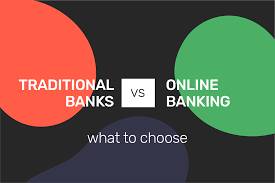Digital Banking vs. Traditional Banking: Which Should Be a Better Choice?
In recent years, the banking landscape has undergone a significant transformation, driven largely by technological advancements. Digital banking has emerged as a strong alternative to traditional banking, offering a variety of services that cater to the evolving needs of consumers. As you consider where to manage your finances, it's essential to weigh the pros and cons of both digital and traditional banking to determine which option best fits your lifestyle.
Understanding Digital Banking
Digital banking refers to the online platforms and mobile applications that allow users to conduct financial transactions without the need to visit a physical bank branch. These banks often operate exclusively online, offering a range of services, including checking and savings accounts, loans, and investment options. Some well-known digital banks include Chime, Ally, and Revolute.
Advantages of Digital Banking:
1. Convenience and Accessibility: Digital banking allows customers to manage their finances anytime and anywhere with an internet connection. Users can check balances, transfer money, and pay bills from their smartphones or computers without needing to visit a branch.
2. Lower Fees: Many digital banks have lower overhead costs than traditional banks since they do not maintain physical branches. As a result, they often pass these savings on to customers in the form of lower fees and higher interest rates on savings accounts.
3. User-Friendly Technology: Digital banking platforms typically prioritize user experience, providing intuitive interfaces and features like budgeting tools, spending analysis, and real-time transaction notifications. These tools can help users manage their finances more effectively.
4. Faster Account Opening and Fund Transfers: Opening an account with a digital bank is usually a quick process, often completed in minutes online. Additionally, many digital banks facilitate instant money transfers, making it easy to send and receive funds.
Disadvantages of Digital Banking:
1. Limited Customer Service Options: While many digital banks offer customer support via chat, email, or phone, the lack of in-person assistance can be a drawback for those who prefer face-to-face interaction. Complex issues may be harder to resolve without direct contact.
2. Less Comprehensive Services: Some digital banks may not offer the same breadth of services as traditional banks, particularly when it comes to complex financial products like mortgages or commercial loans. This can limit options for customers with diverse financial needs.
3. Dependence on Technology: Digital banking requires a reliable internet connection and tech-savvy users. For individuals who are uncomfortable with technology or live in areas with poor connectivity, this can be a significant barrier.
Understanding Traditional Banking
Traditional banking involves physical branches and face-to-face interactions with banking professionals. This model has been the cornerstone of personal finance for centuries, with established institutions like Bank of America, Wells Fargo, and Citi providing a range of services.
Advantages of Traditional Banking:
1. Personalized Service: One of the biggest benefits of traditional banking is the personalized service it offers. Customers can meet with bank representatives to discuss their financial needs, get advice, and develop relationships over time.
2. Wide Range of Services: Traditional banks typically provide a comprehensive suite of financial products, including checking and savings accounts, loans, mortgages, investment services, and retirement accounts. This makes them a one-stop shop for all financial needs.
3. Physical Locations: Having a branch nearby can be advantageous for individuals who prefer to conduct transactions in person. Traditional banks also offer ATMs for cash withdrawals and deposits, which can be more accessible for some customers.
4. Trust and Stability: Established banks often have a long history and a reputation for reliability. Many consumers feel more secure keeping their money in traditional banks, particularly in times of economic uncertainty.
Disadvantages of Traditional Banking:
1. Limited Hours: Traditional banks typically operate during standard business hours, which can be inconvenient for those with busy schedules. Many customers find it challenging to visit a branch during the week.
2. Higher Fees: Traditional banks often charge higher fees for account maintenance, overdrafts, and transactions. These costs can add up over time, especially for those who are not careful with their finances.
3. Less Technological Innovation: While many traditional banks have developed online banking services, they may not offer the same level of technological innovation and user-friendly interfaces as their digital counterparts.
Making Your Choice
Choosing between digital and traditional banking ultimately depends on your personal preferences, lifestyle, and financial needs. Here are some factors to consider:
- Lifestyle: If you prefer the convenience of managing your finances on-the-go and value low fees, digital banking may be the best fit. Conversely, if you appreciate personalized service and have complex financial needs, a traditional bank might be more suitable.
- Technology Comfort: If you’re comfortable using technology and regularly use apps for various aspects of your life, digital banking will likely be an easy transition. However, if you prefer in-person interactions, traditional banking may feel more comfortable.
- Services Needed: Consider what financial products you need. If you require specialized services like mortgages or investment advice, ensure the bank you choose can meet those needs.
Conclusion
Both digital and traditional banking offer unique benefits and drawbacks. By assessing your financial habits, preferences, and needs, you can make an informed decision that aligns with your lifestyle. Whether you choose the convenience of digital banking or the personalized service of traditional banking, the key is to find a solution that empowers you to manage your money effectively. As technology continues to evolve, the banking landscape will likely change, so staying informed about new options will help you adapt to your financial future.


